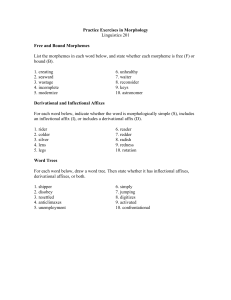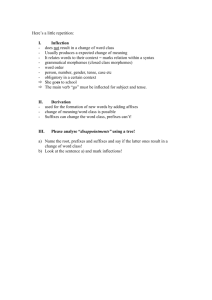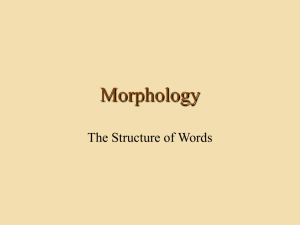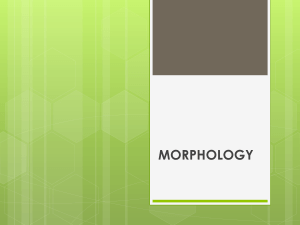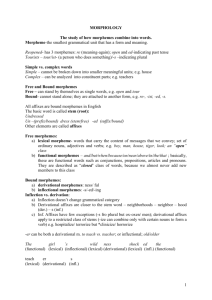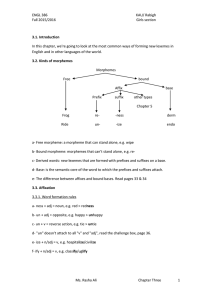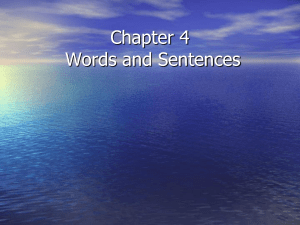LINGUISTICS 200: Introduction to Linguistic Thought
advertisement
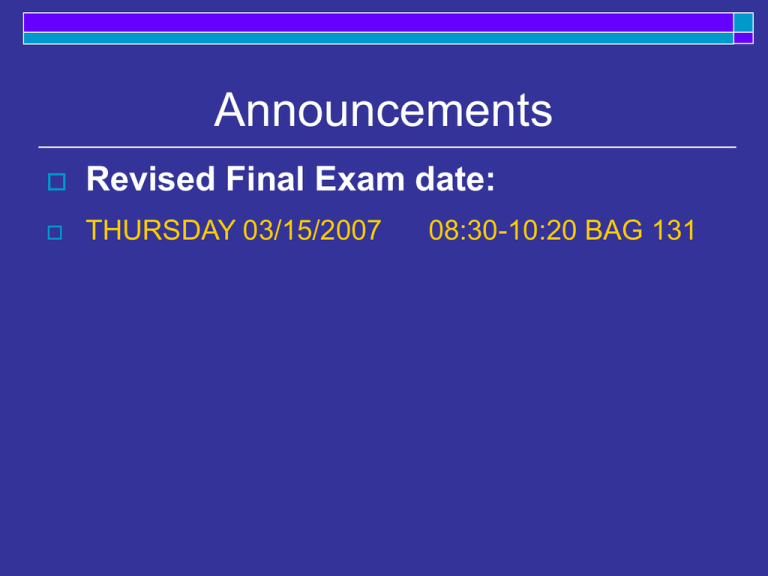
Announcements Revised Final Exam date: THURSDAY 03/15/2007 08:30-10:20 BAG 131 Today What is morphology? Types of morphemes Readings: 5.1, 5.3, 5.4 Morphology The study of words and the rules for word formation in a language What is a word? A meaningful unit of language that can stand on its own Stored in mental lexicon w/ information about its ‘part of speech’ (noun, verb, adj., etc.) Composed of one or more morphemes Morpheme The smallest meaningful linguistic unit apple, cat, help, salamander, fling, lens -er, -ing, -s pre-, un- ‘Oversimplifications’ 1: 2: 3: 4: 5: simple simple + ify simple + ify + cation over + simple + ify + cation over + simple + ify + cation + s Definitions Affix: general term for morphemes attached to a root or stem prefix: beginning of word (e.g., pre-) suffix: end of word (-ness, -ly, -tion) infix: inside a word Tagalog [-um-]: [bili] ‘buy’ [bumili] ‘to buy’ circumfix: ‘around’ a word (at both ends) German [ge- -t]: spiel- ‘play’ gespielt Definitions Root: forms base for affixes to attach to; cannot be analyzed into smaller parts Stem: formed when a root is combined with an affix (that other affixes can continue to be attached to) root: stem: stem: stem: taste dis + taste dis + taste + ful dis + taste + ful + ly (verb) (prefix + verb) (prefix + verb + suffix) (prefix + verb + suffix + suffix) Types of morphemes Bound vs. Free Derivational vs. Inflectional Content vs. Function Free vs. Bound morphemes Free morphemes: can occur as an independent word all by themselves Simple words: cat, eat, green, pumpkin, the, is Free vs. Bound morphemes Bound morphemes: Cannot stand alone, but must be attached to other morphemes Affixes: un-, pre-, dis-, -ly, -ness, -tion Bound roots: -ceive (conceive, receive, deceive, perceive) -sist (consist, resist, desist, persist) I know a little man both ept and ert. An intro-? extro-? No, he's just a vert. Sheveled and couth and kempt, pecunious, ane, His image trudes upon the ceptive brain. When life turns sipid and the mind is traught, The spirit soars as I would sist it ought. Chalantly then, like any gainly goof, My digent self is sertive, choate, loof. attributed to David McCord (b. 1897) I know a little man both ept and ert. An intro-? extro-? No, he's just a vert. Sheveled and couth and kempt, pecunious, ane, His image trudes upon the ceptive brain. When life turns sipid and the mind is traught, The spirit soars as I would sist it ought. Chalantly then, like any gainly goof, My digent self is sertive, choate, loof. attributed to David McCord (b. 1897) Derivational vs. inflectional affixes Derivational affixes: when added to a word, make or derive a new word w/ a new meaning… …sometimes changing the part of speech of the word use (v.) + able usable (adj.) happy (adj.) + ness happiness (n.) …sometimes not un + happy (adj.) unhappy (adj.) re + produce (v.) reproduce (v.) Derivational vs. inflectional affixes Inflectional affixes: indicate grammatical roles; do not change basic meaning of the word, e.g., 3rd per. sg.: past tense: progressive: past participle: plural: possessive: comparative: superlative: -s -ed -ing -en -s -’s -er -est He walks. He walked. He is walking. He has eaten. I have cats. cat’s eye She is older. She is oldest.
